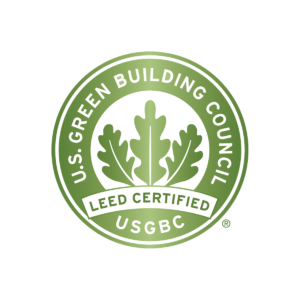LEED stands for Leadership in Energy and Environmental Design, and is among the most recognized green building certifications in the world. It is a ratings system introduced in the US in 1994 by the US Green Building Council (or USGBC) to help building owners and developers incorporate sustainable designs into their building projects. The LEED certification program operates on a points-based system, giving LEED credits in different areas of building sustainability. The number of points an individual project receives determines whether it is ranked as certified, silver, gold, or platinum.
The idea behind LEED was to create a ‘framework for healthy, efficient, carbon and cost-saving green buildings’ according to the USGBC. Over the years, LEED has become a globally recognized symbol of sustainable building achievement and has helped to develop both new construction and renovate existing buildings in a more sustainable way. It also constantly strives to develop and improve its rating system to push sustainable construction to the forefront of the industry.
LEED offers both project certification and individual accreditation to help make the future of the construction industry as sustainable and viable as possible, both in the US and abroad. But how much does LEED certification cost, both to an organization and to an individual? Below you will find more information about the LEED certification process, as well as information about the registration fee, the LEED rating system, and the benefits of being LEED certified.
What is a LEED certification?
All buildings have an impact both on their immediate surroundings and the wider world. Buildings not only require a huge amount of materials to construct, but also generate waste and utilize resources such as electricity, water, and energy. Sustainable design aims to limit the effects of construction and ongoing existence of any building or project, both environmentally and socially.
LEED is an internationally recognized way of grading these efforts towards creating more sustainable buildings and verifying that efforts have been made by the designer, developer, and construction firm to reduce impact. It also aims to integrate forward thinking technologies that represent the future of sustainable design in the construction industry.
LEED project certification measures the reduced impact of any project by looking at several key areas. These include:
- Water use
- Greenhouse gas emissions
- Indoor air quality
- Use of recycled materials
- Utilization of resources
- Maintenance and operation costs
Each project is evaluated according to its performance in the above metrics, scoring points which are tallied to give an overall certification status. The project will fall in one of four certification categories: basic, silver, gold, and platinum (with platinum being the highest level a project can achieve).
LEED certification applies to building projects and is different to LEED accreditation, which is awarded to individuals or professionals working in the industry. It will be awarded on the successful passing of an exam, with the title LEED Green Associate or LEED Accredited Professional status being awarded.
 What are some benefits of LEED certification?
What are some benefits of LEED certification?
There are multiple benefits of LEED building design and construction, which include:
Economic benefits
According to the USGBC, 61% of corporate leaders believe that sustainability leads to an improved financial performance, which means LEED certification can give you a competitive edge when designing commercial buildings. In addition, LEED certification can help buildings to attract tenants and gain superior rental incomes. These can be up to 20% higher than non-certified buildings with 4% lower vacancy rates. Office buildings with happier and healthier occupants also experience much higher retention rates and increased productivity. All of which adds up to a better-looking bottom line.
Health benefits
The EPA estimates that indoor air is between two to ten times more polluted than outdoor air. LEED certification ensures buildings are designed to maximize air quality and minimize exposure to toxins. That’s because it requires proper ventilation and high efficiency filters. This leads to happier and healthier occupants, tenants, or employees. LEED aims to create buildings that bring in the good and keep out the bad. That means working towards spaces with cleaner air, access to daylight, and free from harmful chemicals.
Environmental benefits
Greener designs reduce our dependence on conventional energy and optimize water use, meaning they require less resources for building operations and maintenance . By using more sustainable energy forms, energy efficiency measures, and more sustainable building techniques, a LEED certification can radically reduce the impact of any building. LEED certified projects have diverted more than 80 million tons of waste from landfills already. By 2030 the number is expected to grow to 540 million tons.
How do I become LEED certified?
For a building to become LEED certified it must meet the minimum prerequisites for certification (as outlined below). It also requires the payment of certification fees, which vary according to the size and type of project.
For building owners that wish to become a LEED accredited professional, then you must study the LEED standards closely and sit an exam. Upon passing the exam, you will earn a Green Associate Credential or Accredited Professional (AP) status. Becoming an AP within the building industry can be a great way to enhance your career as LEED APs are always in great demand on projects all around the world.
What Is the cost of LEED certification? – LEED certification fees
LEED registration includes a flat fee paid up front with rates based on the fee schedule published at the time, and it is also possible to pay an additional fee for an expedited review. The certification costs are based on the project’s rating system and size. This will be calculated and paid when the project documentation is submitted for review via LEED Online.
As fees vary according to the scale, type, and location it can be difficult to give an accurate estimate for costs. A full list of up-to-date registration and certification fees can be found here. As part of the LEED package, your fee covers integration and access to the Arc platform and a dedicated LEED coach who will advise you on your project and help you to realize your sustainable goals.
Of course, the costs of LEED are not just direct, in terms of fees. The costs of meeting LEED requirements also need to be considered. The USGBC estimates these to be between $20,000 to $60,000 depending on the size and complexity of the project and whether you are developing a new construction or renovating an existing building. But this can usually be recouped through increased rents and lower bills during the lifespan of the building.
The individual LEED Green Associate exam costs $200 for USGBC members ($250 for non-members). The LEED AP exams each cost $250 for USGBC members ($350 for non-members). It may be cheaper to do both exams at the same time.
What are the minimum requirements for LEED Certification?
In order to meet the minimum requirements of LEED certification, you must look into the following areas and ensure that your project team is working towards the same goals. These include:
- Compliance with environmental regulations and standards
- Meeting the threshold of floor area requirements
- Ensuring a minimum of building occupancy in terms of number of users
- Maintaining a reasonable site boundary
- Must be a permanent building
- Sharing of up-to-date energy and water usage data
- Have a minimum building to site area ratio
- Contributes to neighborhood development
Tips for having your LEED application approved
If you are thinking of beginning the LEED project registration process, then there are a few things that you can do to maximize your chances of gaining certification. For example, you need to demonstrate an understanding of the core principles of the rating system and how the various categories of credit work. If you can demonstrate specialist knowledge in any of these key areas, it will add points to your application and make the process quicker and more likely to succeed.
You should also try and demonstrate the skills exemplified by the USGBC and explain how these will help to meet specific requirements of the project. This could be in waste management, emission reduction, indoor air quality, insulation, materials or more. Additionally.
Remember that the LEED scheme is not punitive and is always looking for new ways to enhance sustainable building across a range of sectors, ensuring the future of green building. It will also be a significant step if you or the organization is already a USGBC member. If you are not already a member, then why not begin the conversation with your employer.
If you would like more information about how to deal with waste in a more sustainable and cost-effective way, then get in touch with RTS today. We can help you create waste management strategies that work for you, and our complete waste services for both businesses and communities can work at any scale. Additionally, explore the RTS blog and get more information on LEED certification and how your business can work towards a more sustainable future.



